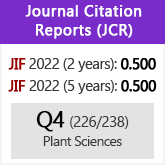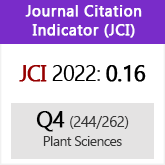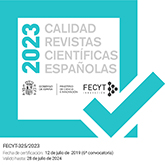Evaluating population and community structure against climate and land-use determinants to improve the conservation of the rare Narcissus pseudonarcissus subsp. nobilis
DOI:
https://doi.org/10.3989/ajbm.2397Keywords:
Endangered species, Iberian Peninsula, land-use, population traits, rural landscapesAbstract
Climate and land-use changes are among the most relevant determinants of future persistence of rare plant species in rural landscapes. We analysed the structure of populations of a rare plant, Narcissus pseudonarcissus subsp. nobilis, and of their respective plant communities against several environmental variables (climate-, topography-, land-use-, and soil-related) in order to identify the pressures that may directly or indirectly affect the persistence of the rare species. Overall, local land-use was the primary determinant of traits related to population renewal and community composition. Specifically, traditional farmlands supported higher community diversity and population individuals. Though moderate land-use intensification seemed to benefit plant community diversity, land abandonment could allow the persistence of N. pseudonarcissus subsp. nobilis populations. Also, a relevant influence of regional environment was perceived on species richness as well as on traits related to population condition, highlighting climate change as a potential determinant of the future persistence of the species. This study highlights the importance of considering key population traits as well as of community structure to accomplish conservation goals by accounting with the factors driving changes in the habitats in which rare species occur, from climate change to land-use and landscape management.
Downloads
References
Aedo, C. 2013. Narcissus L. in Rico, E, Crespo, M.B., Quintanar A. Aedo, C. (eds.). Flora iberica 20: 340-397. Real Jardín Botánico, CSIC, Madrid.
Aguiar, C., Honrado, J. & Soutinho, A.D. 2000. Comunidades e complexos de vegetação pratense do Noroeste de Portugal. Pastagens e Forragens 21: 29-50.
Albert, C.H., Thuiller, W., Yoccoz, N.G., Douzet, R., Aubert, S. & Lavorel, S. 2010. A multi-trait approach reveals the structure and the relative importance of intra- vs. interspecific variability in plant traits. Functional Ecology 24: 1192-1201. http://dx.doi.org/10.1111/j.1365-2435.2010.01727.x
Barkham, J.P. 1980a. Population dynamics of the wild daffodil (Narcissus pseudonarcissus). I. Clonal growth, seed reproduction, mortality and the effects of density. Journal of Ecology 68: 607-633. http://dx.doi.org/10.2307/2259425
Barkham, J.P. 1980b. Population dynamics of the wild daffodil (Narcissus pseudonarcissus). II. Changes in number of shoots and flowers, and the effect of bulb depth on growth and reproduction. Journal of Ecology 68: 635-664. http://dx.doi.org/10.2307/2259426
Barkham, J.P. 1992. Population dynamics of the wild daffodil (Narcissus pseudonarcissus). IV. Clumps and gaps. Journal of Ecology 80: 797-808. http://dx.doi.org/10.2307/2260867
Baur, B., Cremene, C., Groza, G., Rakosy, L., Schileyko, A.A., Baur, A., Stoll, P. & Erhardt, A. 2006. Effects of abandonment of subalpine hay meadows on plant and invertebrate diversity in Transylvania, Romania. Biological Conservation 132: 261-273. http://dx.doi.org/10.1016/j.biocon.2006.04.018
Bielsa, I., Pons, X. & Bunce, B. 2005. Agricultural abandonment in the North Eastern Iberian Peninsula: the use of basic landscape metrics to support planning. Journal of Environmental Planning and Management 48: 85-102. http://dx.doi.org/10.1080/0964056042000308166
Billeter, R., Liira, J., Bailey, D., Bugter, R., Arens, P., Augenstein, I., Aviron, S., Baudry, J., Bukacek, R., Burel, F., Cerny, M., de Blust, G., de Cock, R., Diekötter, T., Dietz, H., Dirksen, J., Dormann, C., Durka, W., Frenzel, M., Hamersky, R., Hendrickx, F., Herzog, F., Klotz, S., Koolstra, B., Lausch, A., le Coeur, D., Maelfait, J.P., Opdam, P., Roubalova, M., Schermann, A., Schermann, N., Schmidt, T., Schweiger, O., Smulders, M.J.M., Speelmans, M., Simova, P., Verboom, J., van Wingerden, W.K.R.E., Zobel, M. & Edwards, P.J. 2008. Indicators for biodiversity in agricultural landscapes: a pan-European study. Journal of Applied Ecology 45: 141-150. http://dx.doi.org/10.1111/j.1365-2664.2007.01393.x
Bilz, M., Kell, S.P., Maxted, N. & Lansdown, R.V. 2011. European Red List of Vascular Plants. Publications Office of the European Union. Luxembourg. PMid:21246466
Bratli, H., Økland, T., Økland, R.H., Dramstad, W.E., Elven, R., Engan, G., Fjellstad, W., Heegaard, E., Pedersen, O. & Solstad, H. 2006. Patterns of variation in vascular plant species richness and composition in SE Norwegian agricultural landscapes. Agriculture, Ecosystems & Environment 114: 270-286. http://dx.doi.org/10.1016/j.agee.2005.10.022
Broennimann, O., Vittoz, P., Moser, D. & Guisan, A. 2005. Rarity types among plant species with high conservation priority in Switzerland. Botanica Helvetica 115: 95-108. http://dx.doi.org/10.1007/s00035-005-0713-z
Castroviejo, S. et al. 1986-2015. Flora iberica 1-18, 20-21. Real Jardín Botánico, CSIC, Madrid.
Colling, G., Hemmer, P., Bonniot, A., Hermant, S. & Matthies, D. 2010. Population genetic structure of wild daffodils (Narcissus pseudonarcissus L.) at different spatial scales. Plant Systematics and Evolution 287: 99-111. http://dx.doi.org/10.1007/s00606-010-0298-x
Cornelissen, J.H.C., Lavorel, S., Garnier, E., Díaz, S., Buchmann, N., Gurvich, D.E. & Reich, P.B., ter Steege, H., Morgan, H.D., van der Heijden, M.G.A., Pausas, J.G. & Poorter, H .2003. A handbook of protocols for standardised and easy measurement of plant functional traits worldwide. Australian Journal of Botany 51: 335-380. http://dx.doi.org/10.1071/BT02124
Cousins, S.A.O. & Lindborg, R. 2004. Assessing changes in plant distribution patterns–indicator species versus plant functional types. Ecological Indicators 4: 17-27. http://dx.doi.org/10.1016/j.ecolind.2003.11.002
Deutschewitz, K., Lausch, A., Kühn, I. & Klotz S. 2003. Native and alien plant species richness in relation to spatial heterogeneity on a regional scale in Germany. Global Ecology and Biogeography 12: 299-311. http://dx.doi.org/10.1046/j.1466-822X.2003.00025.x
Dietschi, S., Holderegger, R., Schmidt, S.G. & Linder, P. 2007. Agri-environment incentive payments and plant species richness under different management intensities in mountain meadows of Switzerland. Acta Oecologica 31: 216-222. http://dx.doi.org/10.1016/j.actao.2006.10.006
Enyedi, Z.M., Ruprecht, E. & Deák, M. 2008. Long-term effects of the abandonment of grazing on steppe-like grasslands. Applied Vegetation Science 11: 55-62. http://dx.doi.org/10.1111/j.1654-109X.2008.tb00204.x
ESRI. 2010. ArcGIS 10.0. Environmental Systems Research Institute Inc.
Fontaine, B., Bouchet, P., van Achterberg, K., Alonso-Zarazaga, M.A., Araujo, R., Asche, M., Aspöck, U., Audisio, P., Aukema, B., Bailly, N., Balsamo, M., Bank, R.A., Barnard, P., Belfiore, C., Bogdanowicz, W., Bongers, T., Boxshall, G., Burckhardt, D., Camicas, J.-L., Chylarecki, P., Crucitti, P., Deharveng, L., Dubois, A., Enghoff, H., Faubel, A., Fochetti, R., Gargominy, O., Gibson, D., Gibson, R., Gómez López, M.S., Goujet, D., Harvey, M.S., Heller, K.-G., van Helsdingen, P., Hoch, H., de Jong, H., de Jong, Y., Karsholt, O., Los, W., Lundqvist, L., Magowski, W., Manconi, R., Martens, J., Massard, J.A., Massard- Geimer, G., McInnes, S.J., Mendes, L.F., Mey, E., Michelsen, V., Minelli, A., Nielsen, C., Nieto Nafría, J.M., van Nieukerken, E.J., Noyes, J., Pape, T., Pohl, H., de Prins, W., Ramos, M., Ricci, C., Roselaar, C., Rota, E., Schmidt-Rhaesa, A., Segers, H., Strassen, R.Z., Szeptycki, A., Thibaud, J.-M., Thomas, A., Timm, T., van Tol, J., Vervoort, W. & Willmann, R. 2007. The European union's 2010 target: Putting rare species in focus. Biological Conservation 139: 167-185. http://dx.doi.org/10.1016/j.biocon.2007.06.012
Gondard, H., Jauffret, S., Aronson, J. & Lavorel, S. 2003. Plant functional types: a promising tool for management and restoration of degraded lands. Applied Vegetation Science 6: 223-234. http://dx.doi.org/10.1658/1402-2001(2003)006[0223:PFTAPT]2.0.CO;2
González-Oreja, J.A., Garbisu, C., Mijangos, I., Mendarte, S. & Albizu, I. 2013. Reducing costs in biodiversity monitoring: Shortcuts for plant diversity in meadows as a case study. Ecological Indicators 24: 96-104. http://dx.doi.org/10.1016/j.ecolind.2012.06.008
Halada, L., Evans, D., Romão, C. & Petersen, J.-E. 2011. Which habitats of European importance depend on agricultural practices? Biodiversity Conservation 20: 2365-2378. http://dx.doi.org/10.1007/s10531-011-9989-z
Hampton, M. 2008. Management of Natura 2000 habitats. 4010 Northern Atlantic wet heaths with Erica tetralix. Technical Report 2008 08/24. European Commission.
Hanks, G.R. 2002. Narcissus and Daffodil: The Genus Narcissus. Taylor & Francis Inc.. New Fetter Lane. London.
Hoare, J.M., Monks, A. & O'Donnell, C.F.J. 2013. Do population indicators work? Investigating correlated responses of bird populations in relation to predator management. Ecological Indicators 25: 23-34. http://dx.doi.org/10.1016/j.ecolind.2012.09.007
Honrado, J.P., Alves, P., Alves, H.N. & Caldas, F.B. 2002. Natural and semi-natural vegetation of the "Alto Minho". In: Honrado JP, Alves HN, Caldas FB, editors. Flora and Vegetation of the "Alto Minho". Excursion Guide of the "IV ALFA Meeting".: Associação Lusitana de Fitossociologia. pp 18–57. Porto.
ICNF. 2006. Plano sectorial da Rede Natura 2000. Fichas de caracterização e gestão das espécies constantes do anexo II da Directiva Habitats. [URL]: http://www.icnf.pt/portal/naturaclas/rn2000/p-set (Accessed 21st November, 2014).
ICNF. 2012. Sítios de importância comunitária: A Rede Natura 2000 em Portugal. Lisbon, Portugal. [URL]: http://www.icnf.pt/portal/naturaclas/cart/ap-rn-ramsar-pt (Accessed 21st November, 2014).
Kent, M. & Coker, P. 1992. Vegetation description and analysis: a practical approach. Wiley-Blackwell, West Sussex. UK.
Kleijn, D., Rundlöf, M., Scheper, J., Smith, H.G. & Tscharntke, T. 2011. Does conservation on farmland contribute to halting the biodiversity decline? Trends in Ecology and Evolution 26: 474-481. http://dx.doi.org/10.1016/j.tree.2011.05.009 PMid:21703714
Kleyer, M., Dray, S., Bello, F., Lep?, J., Pakeman, R.J., Strauss, B., Thuiller, W. & Lavorel, S. 2012. Assessing species and community functional responses to environmental gradients: Which multivariate methods? Journal of Vegetation Science 23: 805-821. http://dx.doi.org/10.1111/j.1654-1103.2012.01402.x
Klimek, S., gen. Kemmermann, A.R., Hofmann, M. & Isselstein, J. 2007. Plant species richness and composition in managed grasslands: The relative importance of field management and environmental factors. Biological Conservation134: 559-570. http://dx.doi.org/10.1016/j.biocon.2006.09.007
Lavorel, S., Grigulis, K., Lamarque, P., Colace, M.-P., Garden, D., Girel, J., Pellet, G. & Douzet, R. 2011. Using plant functional traits to understand the landscape distribution of multiple ecosystem services. Jounal of Ecology 99: 135-147. http://dx.doi.org/10.1111/j.1365-2745.2010.01753.x
Lindborg, R. & Ehrlén, J. 2002. Evaluating the Extinction Risk of a Perennial Herb: Demographic Data versus Historical Records. Conservation Biology 16: 683-690. http://dx.doi.org/10.1046/j.1523-1739.2002.00509.x
Lomba, A., Gonçalves, J., Moreira, F. & Honrado, J. 2012. Simulating long-term effects of abandonment on plant diversity in Mediterranean mountain farmland. Plant Biosystems 147: 1-19.
Lomba, A., Pellissier, L., Randin, C., Vicente, J., Moreira, F., Honrado, J. & Guisan, A. 2010. Overcoming the rare species modelling paradox: A novel hierarchical framework applied to an Iberian endemic plant. Biological Conservation 143: 2647-2657. http://dx.doi.org/10.1016/j.biocon.2010.07.007
Lomba, A., Guerra, C., Alonso, J., Honrado, J.P., Jongman, R. & McCracken, D. 2014. Mapping and monitoring High Nature Value farmlands: Challenges in European landscapes. Journal of Environmental Management. 143: 140-50. http://dx.doi.org/10.1016/j.jenvman.2014.04.029 PMid:24905644
Lozano, F.D., Herbada, D.G., Rivero, L.M., Saiz, J.C.M. & Ollero, H.S. 1996. Threatened plants in Peninsular and Balearic Spain: A report based on the EU Habitats Directive. Biological Conservation 76: 123- 133. http://dx.doi.org/10.1016/0006-3207(95)00107-7
Moreira, A. & Ribeiro, M.L. 1991. Carta Geológica do Parque Nacional da Peneda-Gerês à escala 1/50000. Serviços Geológicos de Portugal e Serviço Nacional de Parques Reservas e Conservação da Natureza.
Plieninger, T., Hui, C., Gaertner, M. & Huntsinger, L. 2014. The impact of land abandonment on species richness and abundance in the Mediterranean Basin: A Meta-Analysis. PLoS ONE 9: e98355. http://dx.doi.org/10.1371/journal.pone.0098355 PMid:24865979 PMCid:PMC4035294
Quinn, G.P. & Keough, M.J. 2002. Experimental design and data analysis for biologists. Press Syndicate of the University of Cambridge. UK. http://dx.doi.org/10.1017/CBO9780511806384
Regnery, B., Couvet, D. & Kerbiriou, C. 2013. Offsets and conservation of the species of the EU Habitats and Birds Directives. Conservation Biology 27: 1335-1343. http://dx.doi.org/10.1111/cobi.12123 PMid:24033535
Rodríguez-Rojo, M.P. & Sánchez-Mata, D. 2004. Mediterranean hay meadow communities: diversity and dynamics in mountain areas throughout the Iberian Central Range (Spain). Biodiversity Conservation 13: 2361-2380. http://dx.doi.org/10.1023/B:BIOC.0000047918.00589.90
Santos, F.D., Forbes, K. & Moita, R. 2001. Climate Change in Portugal. Scenarios, Impacts and Adaptation measures. SIAM. Executive Summary and Conclusions. Fundação Calouste Gunbenkian. Lisboa.
Schneiders, A., van Daele, T., van Landuyt, W. & van Reeth, W. (2012) Biodiversity and ecosystem services: Complementary approaches for ecosystem management? Ecological Indicators 21: 123-133. http://dx.doi.org/10.1016/j.ecolind.2011.06.021
Shipley, B., Vile, D. & Garnier, É. 2006. From plant traits to plant communities: A statistical mechanistic approach to biodiversity. Science 314: 812-814. http://dx.doi.org/10.1126/science.1131344 PMid:17023613
Smart, S.M., Henrys, P.A., Purse, B.V., Murphy, J.M., Bailey, M.J. & Marrs, R.H. 2012. Clarity or confusion? Problems in attributing large-scale ecological changes to anthropogenic drivers. Ecological Indicators 20: 51-56. http://dx.doi.org/10.1016/j.ecolind.2012.01.022
ter Braak, C.J.F. & Smilauer, P. 2002. CANOCO Reference Manual and Canodraw for Window's User's Guide: Software for Canonical Community Ordination (version 45). Ithaca. NY.
Vassilev, K., Pedashenko, H., Nikolov, S.C., Apostolova, I. & Dengler, J. 2011. Effect of land abandonment on the vegetation of upland semi-natural grasslands in the Western Balkan Mts, Bulgaria. Plant Biosystems 145: 654-665. http://dx.doi.org/10.1080/11263504.2011.601337
Vicente, J., Randin, C.F., Gonçalves, J., Metzger, M.J., Lomba, A., Honrado, J. & Guisan, A. 2011. Where will conflicts between alien and rare species occur after climate and land-use change? A test with a novel combined modelling approach. Biological Invasions 13: 209-1227. http://dx.doi.org/10.1007/s10530-011-9952-7
Violle, C., Navas, M.-L., Vile, D., Kazakou, E., Fortunel, C., Hummel, I. & Garnier, E. 2007. Let the concept of trait be functional! Oikos 116: 882- 892. http://dx.doi.org/10.1111/j.0030-1299.2007.15559.x
Wallin, L. & Svensson, B. 2012. Reinforced traditional management is needed to save a declining meadow species: a demographic analysis. Folia Geobotanica 47: 231-247. http://dx.doi.org/10.1007/s12224-012-9123-3
Winter, S., Penker, M. & Kriechbaum, M. 2011. Integrating farmers' knowledge on toxic plants and grassland management: a case study on Colchicum autumnale in Austria. Biodiversity and Conservation 20: 1763-1787. http://dx.doi.org/10.1007/s10531-011-0060-x
Downloads
Published
How to Cite
Issue
Section
License
Copyright (c) 2016 Consejo Superior de Investigaciones Científicas (CSIC)

This work is licensed under a Creative Commons Attribution 4.0 International License.
© CSIC. Manuscripts published in both the printed and online versions of this Journal are the property of Consejo Superior de Investigaciones Científicas, and quoting this source is a requirement for any partial or full reproduction.All contents of this electronic edition, except where otherwise noted, are distributed under a “Creative Commons Attribution 4.0 International” (CC BY 4.0) License. You may read here the basic information and the legal text of the license. The indication of the CC BY 4.0 License must be expressly stated in this way when necessary.
Self-archiving in repositories, personal webpages or similar, of any version other than the published by the Editor, is not allowed.

















